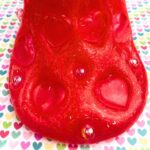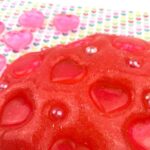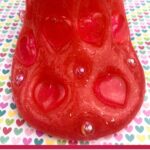Red Heart Slime Recipe
We’ve found quite a few ways to enjoy slime in our home, so adding this red heart slime recipe to the mix has been a great bonus. Not to mention, it’s the perfect experiment and activity to do for Valentine’s Day.
Looking for more activities like this? Check out these awesome Valentine’s Day Science Activities that kids will love.
Keep reading to learn the science behind the slime and just how easy it is to make!
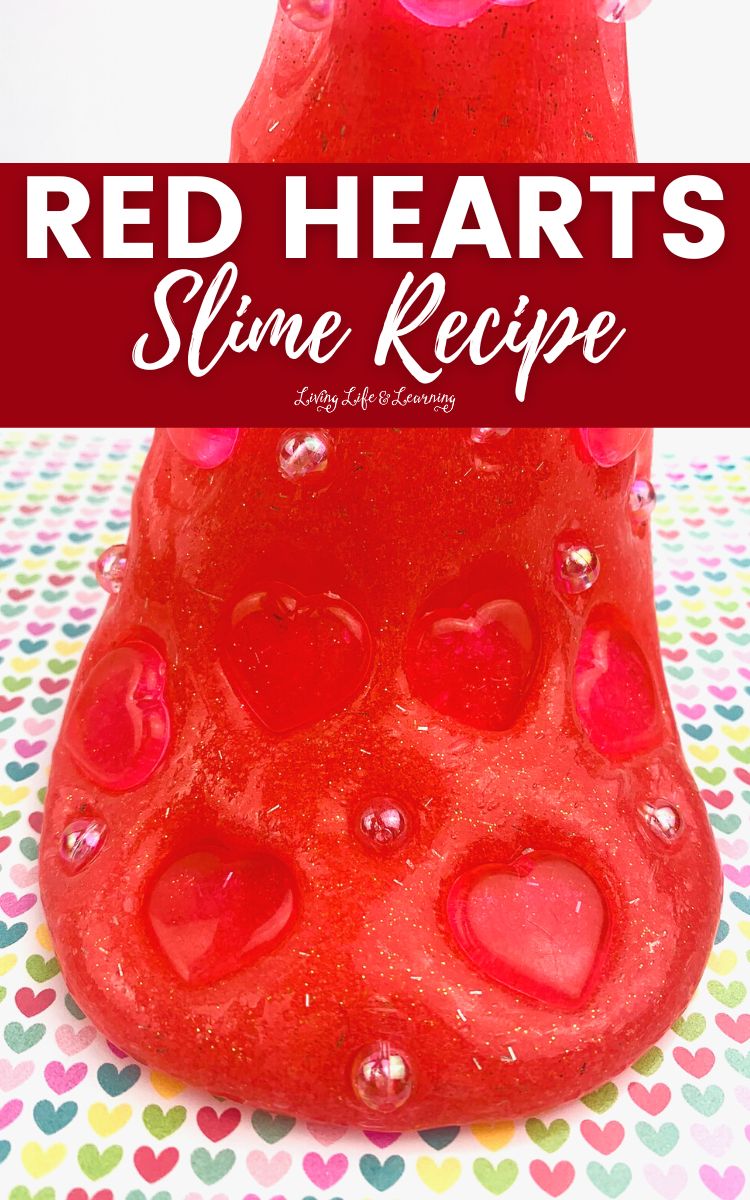
This post may contain affiliate links meaning I get commissions for purchases made through links in this post. Read my disclosure policy here.
The Science Behind Red Heart Slime
If you think your kids are doing just “another activity,” think again! Making red heart slime is actually science and chemistry. It also works those fine motor skills, critical thinking, and listening skills.
While making it, your kids will have the opportunity to learn about the things they’ll see happening right before their eyes. Seeing the ingredients laid out separately, they (and you) may wonder how they come together to make the red heart slime. Here’s how!
>> See more easy slime recipes
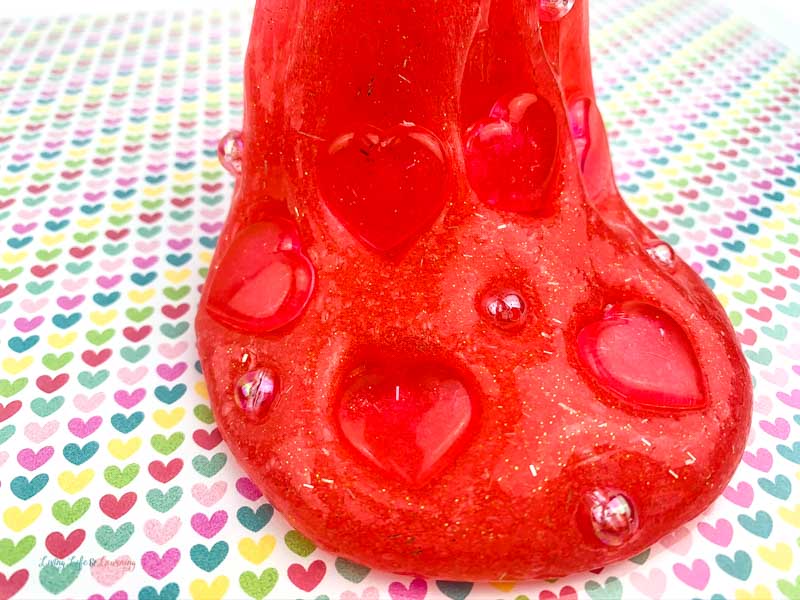
Slime Ingredients
In order to make slime, you’ll need the right kind of ingredients. For starters, you need glue. But not just any kind. Washable school glue, like Elmer’s (classic glitter for this recipe), works the best. Then, you need some slime activators.
These will typically come from the boron family: saline solution, borax powder, or liquid starch. For the red heart slime recipe, we will use baking soda and contact lens solution.
When these ingredients come together, they go through a process known as cross-linking. This is a fancy term used in chemistry and biology to explain what happens when one polymer chain (a very large molecule) is bonded with another.
Recommended Valentine’s Day Books
Bring more excitement to the season with these Valentine’s books for little kids. You will love these great stories about hearts, love, and Valentine’s Day.
Day It Rained HeartsThe Biggest Valentine EverTurkey’s Valentine Surprise (Turkey Trouble Book 6)There Was an Old Lady Who Swallowed a Rose!A Crankenstein ValentineLove, Escargot
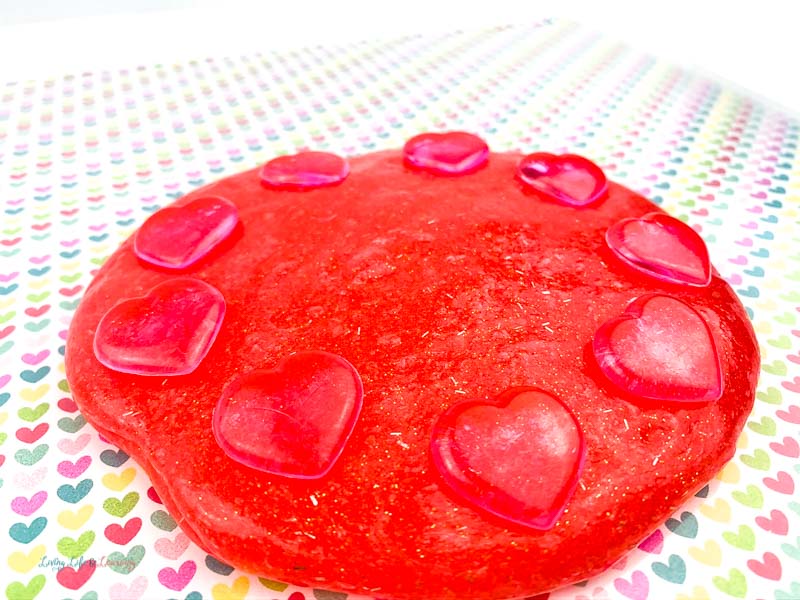
Recommended Science Experiment Books
Love making slime? Try these other recipes or have even more fun with new science experiments that you can explore with household items.
Ultimate Slime Extreme Edition: 100 New Recipes and Projects for Oddly Satisfying, Borax-Free Slime — DIY Cloud Slime, Kawaii Slime, Hybrid Slimes, and More!The Slime BookAwesome Science Experiments for Kids: 100+ Fun STEM / STEAM Projects and Why They Work (Awesome STEAM Activities for Kids)The Kitchen Pantry Scientist Chemistry for Kids: Science Experiments and Activities Inspired by Awesome Chemists, Past and Present; Includes 25 … the World (The Kitchen Pantry Scientist, 1)Kitchen Science Lab for Kids: 52 Family Friendly Experiments from Around the House (Lab for Kids (4))The 101 Coolest Simple Science Experiments: Awesome Things To Do With Your Parents, Babysitters and Other Adults
Chemistry in the Red Heart Slime
Once the cross-linking of the ingredients – Elmer’s glitter glue, baking soda, and contact lens solution – has been completed, they begin to change in terms of their atomic and molecular makeup and create a new substance – slime!
The neatest part about creating slime is it becomes a substance known as a non-Newtonian fluid. This means it is neither a solid nor a liquid. When you pick up it, it may feel solid, but will quickly begin to ooze like a liquid!
Slime will also take the shape of the container it is in. And although it doesn’t have a shape of its own, it can still be bounced like a ball due to its elasticity. The chemical bonding of slime will allow you to pull slowly and it stay together.
However, if you pull it quickly, it will break. This happens because you are breaking it’s chemical bond before it can stay together (like when pulling it slowly).
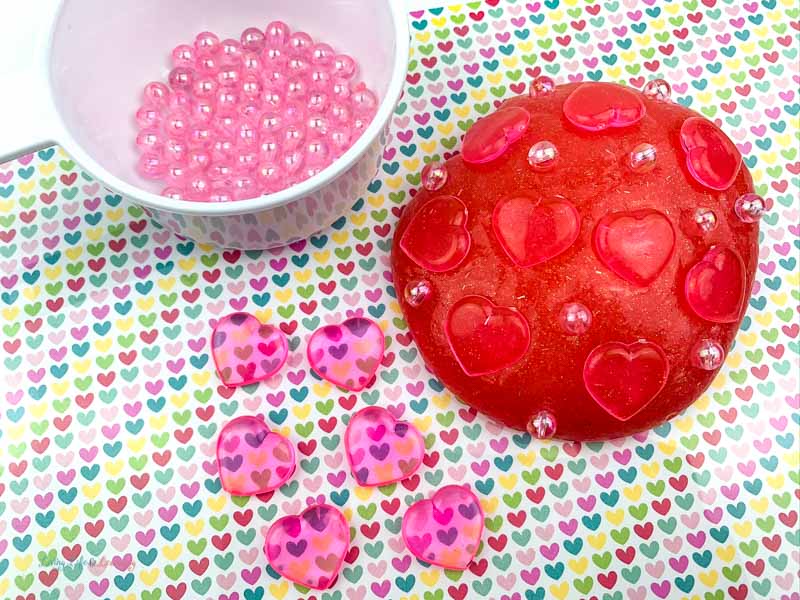
>> See more Valentine’s Day Activities for Kids
Why Red Slime is Stretchy?
Speaking of stretching and pulling slime, your kids may wonder how this is possible. Thanks to the polymers I mentioned earlier, the glue can keep its flowing texture but without the drying out or overly sticky feel that you’d normally get with glue.
Looking more closely at how polymers work in the red heart slime, the glue is made up of long chains of polyvinyl acetate molecules. These molecules then bond with the slime activators (baking soda and contact lens solution) and grow through a change of position.
The chemical reaction between the glue and borate ions creates the slime.
Pretty cool, huh?
If your kids love STEM activities, you must try these Valentine STEM Activities packed with exciting science experiments, slime recipes, engineering a structure challenge, and more!
How to Make Red Heart Slime
First, you’ll want to gather all the supplies listed below. In addition to the main three ingredients used to make the red heart slime, you’ll need a few mixing supplies. Don’t forget we’re making it Valentine’s Day-related, so grab some heart gems, beads, and whatever else you want to add.
Also, this recipe is something the entire family can enjoy making together. Get all hands on deck and have a slimey good time! make sure younger kids are supervised at all times as some of the ingredients should not be consumed.
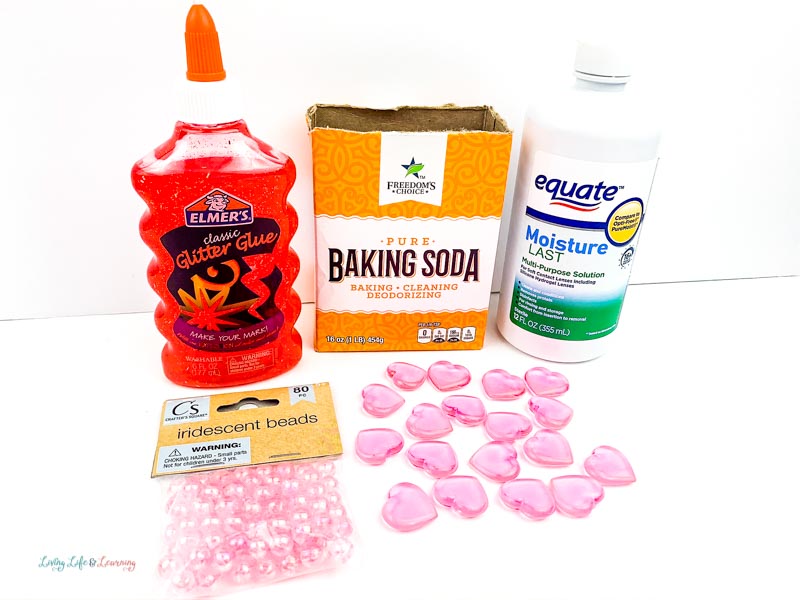
Red Heart Slime Supplies
- Bottle of Red Elmer’s Glitter Glue
- Baking Soda
- Contact lens solution
- Mixing bowl
- Spoon
- Measuring spoons
- Plastic mat
- Heart gems
- Beads
Arm & Hammer Pure Baking Soda (15 lbs.)Elmer’s 2022912 Liquid Glitter Glue, Washable, Gold, 6 Ounces, 1 CountRenu Contact Lens Solution by Multi Purpose Disinfectant Advanced Formula Kills 99.9% Germs, 12 Fl Oz5pcs Measuring Spoon Set, Heavy Duty Stainless Steel Measuring Spoons for Cooking Baking, Tablespoon Teaspoon for Dry or Liquid Ingredients, Fits in Spice Jar, 1/4 1/2 1 tsp, 1/2 1 tbspMECCANIXITY 40 Pcs Acrylic Heart Rhinestone 15mm Flat Back Plastic Gems Jewelry Stickers for Craft Bead Face Painting Costume Jewelry Making, Red700pcs Pearl Beads 6mm Pearl Craft Beads Round Loose Pearls with Holes for Sewing Crafts Decoration Bracelet Necklace Jewelry Making (Red)
How to make the Red Heart Slime?
Follow these easy 7 steps and your kids will have their red heart slime:
- Pour all of the glue into a mixing bowl.
- Add the baking soda. Stir well until combined.
- Add the contact solution.
- Stir until slime forms.
- Knead the slime with your hands until you get the desired consistency.
- Place the dough on a plastic play mat.
- Add the heart gems and beads.
Side note: If you would like to create slime without using an activator from the Borax family, you certainly can! Just know the texture of your slime will be different than the kind made with the ingredients listed above. Click here for more information and recipes for borax-free slime.
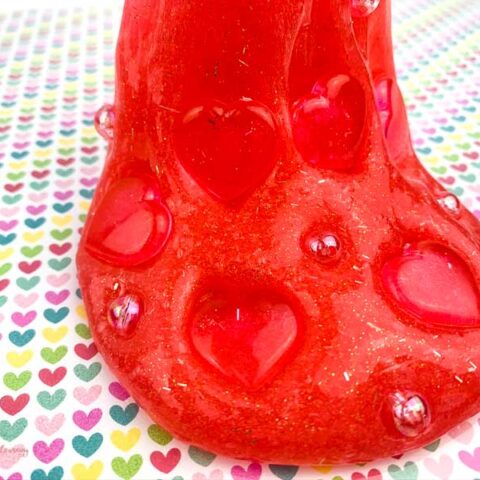
Red Heart Slime Recipe
Try this red heart slime recipe! With its eye-catching color and playful texture, it is sure to impress anyone who sees or touches it.
Materials
- 1 6oz. Bottle of Red Elmer’s Glitter Glue
- ½ Tbsp. Baking Soda
- 1 ¼ tbsp contact lens solution
- Mixing bowl
- Spoon
- Measuring spoons
- Plastic mat
- Heart gems
- beads
Instructions
- Pour all of the glue into a mixing bowl.
- Add the baking soda. Stir well until combined.
- Add the contact solution.
- Stir until slime forms.
- Knead the slime with your hands until you get the desired consistency.
- Place the dough on a plastic play mat.
- Add the heart gems and beads.
Recommended Products
As an Amazon Associate and member of other affiliate programs, I earn from qualifying purchases.
And there you have it – red heart slime! Did you make this recipe? Let me know in the comments below!
More Valentine’s Day Activities
Valentine STEM Activities for Kindergarten
Candy Heart Science Experiments
Valentine’s Candy Hearts Science Activity by Curriculum Castle



